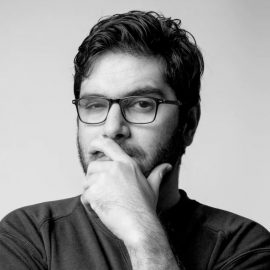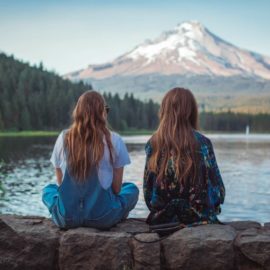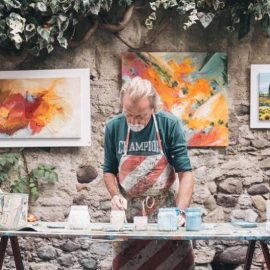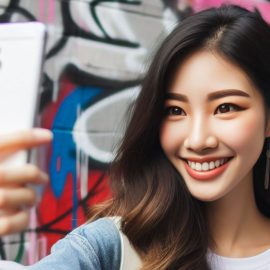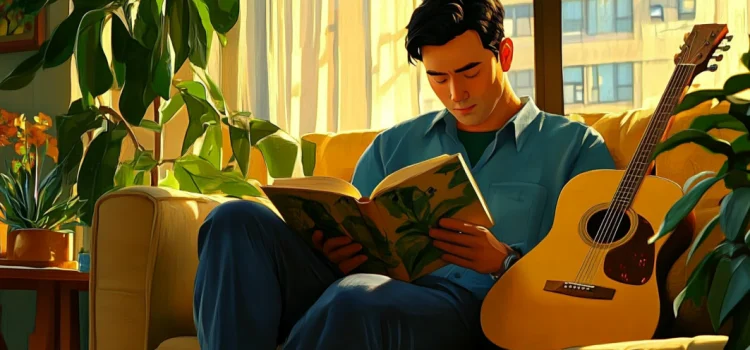
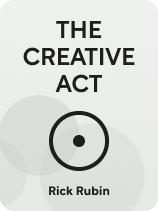
This article is an excerpt from the Shortform book guide to "The Creative Act" by Rick Rubin. Shortform has the world's best summaries and analyses of books you should be reading.
Like this article? Sign up for a free trial here.
Do you want to learn how to tap into your natural creative instincts? How can you live your life with sustained originality and imagination?
The Creative Act, a book by music producer Rick Rubin, argues that every person is an artist, explaining that creativity isn’t about what you make, but a way of being in the world. The Creative Act isn’t just for artists or musicians—it’s a guide for anyone looking to live a rich and creative life.
Continue reading for an overview of this inspiring book.
Overview of The Creative Act
In The Creative Act, book author and music producer Rick Rubin shares his insights on creativity, explaining that creativity isn’t about what you make, but instead a way of being in the world. According to Rubin, whether or not you create something tangible or visible, every person is an artist because our lives are a constant act of self-expression. This shift in perspective will help you access your creative potential.
Rubin offers practical suggestions to help you tap into your natural creative instincts and live your life with sustained originality and imagination. His approach encourages you to think differently and experience the world with a whole new level of engagement. The Creative Act isn’t just for artists or musicians—it’s a guide for anyone looking to live a rich and creative life.
Rubin is a music industry executive and producer. Known for his diverse musical expertise, he has made significant contributions to different genres including hip-hop, alternative rock, heavy metal, and country. He started his career in the music industry in 1981, co-founding Def Jam Recordings with entrepreneur Russell Simmons. Rubin’s production credits include work with artists such as the Beastie Boys, Run-DMC, LL Cool J, Red Hot Chili Peppers, Johnny Cash, and Adele, showcasing his ability to cross musical boundaries. In 2007, MTV called Rubin “the most important producer of the last 20 years” and in the same year, Time Magazine listed Rubin as one of the “100 Most Influential People in the World”.
In this guide, we’ll begin by defining creativity and talking about why it matters. We’ll then cover Rubin’s advice on how you can be more creative in your daily life, from being more playful to making creativity a habit to seeing inspiration everywhere. We’ll also discuss some common barriers to creativity and how to counteract them, as well as the four stages of the creative process according to Rubin. Throughout the guide, we’ll supplement Rubin’s advice with insights and practical tips from other creative thinkers, including Julia Cameron (The Artist’s Way), Elizabeth Gilbert (Big Magic), and Cal Newport (Deep Work).
What Is Creativity?
According to Rubin, creativity isn’t a gift granted to the few, but something that’s available to anyone. He argues that every person is an artist because, regardless of whether or not you’re “making art,” you practice creativity through your daily self-expression—the outfits you put together, the relationships you build, the way you feel or move when you listen to a song, the observations you make as you walk down the street. Your experience of the world is unique to your perspective. You’re creative just by being.
Where Does Creativity Come From?
Rubin posits that creativity isn’t something one simply does, but rather an expression of self. He explains that every person has a connection with a source beyond their everyday selves. This source, as Rubin describes it, is a universal wellspring of creativity and inspiration. It’s not an external entity, but rather an innate part of human consciousness that transcends any individual. He argues this source is accessible through introspection, mindfulness, and the cultivation of an open, receptive state of mind.
Rubin advocates for seeing yourself as a conduit for creativity rather than its source. He argues that this perspective helps overcome common creative barriers like fear of judgment or failure by reducing personal attachment to the work and easing the pressure to produce “brilliant” ideas. Viewing creativity as flowing through you promotes openness to inspiration and lessens self-criticism. By remaining receptive and allowing ideas to arise naturally, you can more easily enter a productive flow state, free from self-imposed anxieties that often hinder creation.
Rubin also introduces the idea of a filter—each person’s unique set of experiences, perspectives, tastes, and skills that they use to interpret and shape incoming ideas. The filter is how artists leave their mark on their work.
By opening yourself as a vessel to receive creative energy from the source, you can then express your unique self through your personal filter, resulting in authentic and original work. Rubin suggests that finding harmony between being open to universal inspiration and applying your unique perspective is essential for living a meaningful, creative life. He suggests that you cultivate both aspects: opening yourself up fully to receive inspiration and ideas from the source, while also developing your unique perspective and skills to shape those ideas into original works.
Why Does Creativity Matter?
According to Rubin, creation is our fundamental reason for being. He argues that creativity is an essential aspect of human existence, connecting us to our deepest selves and the world around us. By engaging in creative acts, you not only express your individual self but also contribute to the collective human experience, fostering empathy, understanding, and innovation.
Rubin argues that all creative expression matters. Every creative act, regardless of its nature or magnitude, is a testament to human existence and contributes to our understanding of our shared reality. And Rubin isn’t just talking about traditional artistic pursuits like painting or dance; he broadens the definition of creativity to include any act of bringing something new into existence, whether it’s a painting, a business idea, or a scientific theory. He explains that every act of creation, no matter the field, helps us recognize that we aren’t alone and are part of something larger than ourselves.
How Can You Be More Creative?
Now that we’ve discussed the importance and impact of creativity, we’ll outline Rubin’s advice for living more creatively. He argues that creativity is less about what you produce and more about how you engage with the world. He offers suggestions for how to cultivate a mindset that invites creativity: You must pay attention, be open and playful, and build a creative habit.
Pay Attention
First, Rubin argues, creativity requires paying attention. He says that being truly aware—both of yourself and your surroundings—can dramatically enhance your ability to create profound and meaningful work.
Rubin encourages you to cultivate a practice of quiet observation, suggesting that noticing the minute details around you can open up new avenues for inspiration. Rubin emphasizes that your awareness should extend beyond the physical world—also tune into your inner thoughts and feelings without judgment. By doing so, you can tap into a deeper level of intuition and authenticity in your work.
Be Open and Playful
According to Rubin, curiosity requires you to be open to multiple possibilities so he suggests staying open and playful. He explains that as children we are immensely creative, in part because we are more focused on what could be rather than what is. However, as we grow older, we begin to categorize, compare, and edit information in ways that make it easier to process, but also limit our creativity. For example, if a child is given a piece of paper, they might see it not just as a medium for drawing or writing, but perhaps as raw material for making a paper boat or a ticket to an imaginary theme park. They see possibilities beyond the obvious.
Being open to unexpected possibilities sometimes means you need to ignore the rules. According to Rubin, rules come in many forms: They may be self-imposed, be common practices in your field or artistic medium, or come from external expectations. While Rubin explains that traditional ways of thinking and doing things can be a place to start, you should never be too attached to them. To keep your thinking fresh, he recommends you consistently question why you’re doing something, and notice when you’re limited by conscious or unconscious rules.
When you’re trying to think outside the box, cultivate a beginner’s mindset, says Rubin. This approach—characterized by openness, humility, and curiosity—encourages you to break out of entrenched ways of thinking and working and see your work with fresh eyes, encouraging you to explore and experiment. By adopting this mindset, you pave the way for innovation. According to Rubin, true creative breakthroughs often stem from the willingness to explore uncharted territory and accept the possibility of failure.
Build a Creative Habit
Rubin writes that when you pay attention and stay open, you continuously gather information to serve as source material for later creative work. However, in order to do creative work, you must build a creative habit.
To support your creativity, he suggests setting up daily or weekly rituals that facilitate your entry into an immersive creative state. He recommends creating a predictable space and time where your mind knows it’s time to switch into a creative mode. According to Rubin, these rituals could range from meditating before starting your work to establishing a routine time and place where you can be uninterrupted and focused.
Rubin emphasizes the importance of consistency in these practices. It’s not just about setting aside time for creativity when you feel inspired; it’s about committing to these periods regularly, regardless of whether inspiration strikes immediately. This dedication helps in building a muscle for creativity, making it easier over time to enter into deep creative work.
Furthermore, Rubin suggests minimizing distractions during these ritual periods. This could mean turning off your phone, using tools that block digital interruptions, or choosing environments where you’re less likely to be disturbed. The goal is to protect the sanctity of your creative time as much as possible.
At times focusing on your creative work will require you to fully immerse yourself in a project, giving your undivided attention to your project for extended periods and allowing it to consume your thoughts and energy. Rubin argues that when you immerse yourself, you develop a deeper connection with your work, potentially entering a flow state of effortless concentration and peak performance. This intense focus helps you overcome creative blocks and heightens awareness of nuances in your work. However, Rubin acknowledges the need to balance this deep engagement with rest as necessary.
Find Inspiration Everywhere
Rubin also encourages you to stay open to inspiration, even outside of these structured times, as life itself offers endless fodder for creativity. By paying attention to the world around you, you continually gather information that might serve as source material for later work. You can look for inspiration in nature, in people, and in the art that other people have made.
Overcome Barriers to Creativity
Rubin also points out common thought patterns that discourage and limit creativity, including self-doubt, internal and external expectations, and projects with a predetermined purpose. He gives some advice for overcoming these barriers.
Self-Doubt
This is one of the most paralyzing challenges creatives face. Rubin highlights how doubting your ability or worthiness to create can stop you before you even start. He advises pushing past these doubts by focusing on the process rather than pre-judging the outcome. Remember, every creator experiences doubt; what distinguishes successful creators is their ability to proceed in spite of it.
When it comes to artistic “skill,” Rubin asserts that while mastering certain skills can be beneficial, the essence of creativity often lies in your unique perspective rather than in technical perfection. Embrace where you are in your skill development as part of your unique creative voice.
Expectations
Many creators set high expectations for their work, which can lead to disappointment if those expectations aren’t met. Rubin suggests releasing any attachment to how your project “should” turn out, allowing creativity its own direction and flow. Art might evolve in unexpected ways; being open to where it leads offers freedom from limiting expectations.
Rubin notes that trying too hard to control the direction of your work stifles its natural evolution. Creativity is often a discovery process—part of its magic lies in not knowing exactly what you’ll uncover along the way. Rather than restricting possibilities by aiming for a predetermined outcome, let go and allow creativity free rein.
Predetermined Purpose
Finally, art often suffocates when it’s created with a predetermined purpose. Rubin explains that treating art as a means to an end—whether for fame, money, or acclaim—places undue pressure on both creator and creation. Rubin emphasizes that creating from a place free from such obligations allows for purer expression and often results in more compelling work because it comes from genuine exploration rather than an attempt at fulfilling external goals or metrics.
For example, imagine you’re a novelist who begins writing with a predetermined message about climate change. You find yourself constantly adjusting your characters and plot to fit this theme, often sacrificing authentic development and discarding intriguing ideas that don’t directly support your message. Following Rubin’s advice, you let go of the predetermined theme and allow the story to develop naturally. Surprisingly, environmental themes still emerge, but in more subtle and nuanced ways. Your resulting novel explores the complex relationships between individuals and their environment through rich character interactions and unexpected plot twists.
According to Rubin, this organic approach will lead to a more compelling and thought-provoking narrative than your original, message-driven concept.
The Creative Process
Now that you know how to cultivate the right mindset to encourage creativity, we’ll discuss the creative process. According to Rubin, there are four stages: gathering, experimenting, crafting, and completing.
Stage 1: Gathering
In the gathering stage, which Rubin calls the “seed phase,” you collect inspirations, ideas, and materials that will feed into your work. This stage is about being open to everything around you and absorbing influences. It’s not yet about making decisions but about exposure to as wide a range of stimuli as possible. Think of it as laying the groundwork or planting seeds that have the potential to grow in various directions.
Stage 2: Experimentation
Following the collection of ideas comes experimentation. In this phase, you begin playing with the ideas you’ve gathered—mixing them, matching them, testing out different combinations without concern for coherence or finality. This is a crucial part of discovering what works and what doesn’t, often leading to unexpected breakthroughs or new directions for your work.
Stage 3: Crafting
After experimenting with various ideas and identifying promising avenues, you enter the crafting phase. Here, says Rubin, you shift your focus toward refinement and development—taking those rough concepts discovered during experimentation and shaping them into something more coherent and tangible. Attention to detail becomes paramount as you work on honing your project’s structure, aesthetics, or functionality depending on your medium.
Stage 4: Completing
The final stage is all about bringing your project across the finish line—completing it. This involves final adjustments like editing for clarity or consistency in written works, fine-tuning balance in music, adding last touches in visual arts, and so one to ensure everything aligns with your vision. It’s also about recognizing when to stop tweaking, understanding that perfection might be an impossible target and that completion itself is a significant achievement.
Rubin emphasizes that these stages of the creative process aren’t strictly linear—you might find yourself moving back to gather more information after experimenting or returning to experimentation even within the crafting phase as new insights emerge.
Everything in the universe, including your creative work, is in a constant state of flux and evolution. Rubin encourages you to accept and embrace the impermanent nature of your work and ideas, highlighting the importance of being adaptable and open to change in the creative process. This perspective suggests that there’s always room for refinement and improvement in creative work, and your (and others’) understanding and interpretation of your work can change over time, offering new insights.
Exercise 1: Reflect on Ways You Already Practice Creativity
Rubin argues that being creative isn’t confined to artistic pursuits but plays a crucial role in various aspects of our lives, from solving problems to finding joy in mundane tasks. This exercise will help you identify the ways you’re already applying creativity in your life.
- First, think about your daily life. When do you feel most creative? Describe what you’re doing in those moments. For example, you might feel most creative when you’re cooking and experimenting with new recipes, combining different ingredients or techniques to create unique dishes.
- Having identified when you feel most creative and what you’re doing in those moments, reflect on how you can incorporate more of these activities or similar tasks into your routine to further stimulate your creativity. For instance, if cooking new recipes makes you feel creative, you could set aside a few hours each week specifically for trying out new dishes or techniques. Alternatively, you might also engage in similar creative tasks like baking.
Exercise 2: Build a Creative Habit
One of the major takeaways from The Creative Act is the importance of building and maintaining a creative habit to foster innovation and productivity. Rubin explains that a creative habit isn’t only something you do when you feel inspired but is an exercise that you must perform every day.
- Write down your current daily schedule including your work, personal time, and recreation.
- Now, identify a time slot you feel can be dedicated to cultivating your creative habit. Consider your most productive hours. Some people might find their creative peak in the tranquility of early mornings, while others might be night owls.
- Define a simple ritual or practice that signifies your transition into this creative time slot. It can be playing a certain type of music, making a cup of coffee, lighting a scented candle, or some other sensory experience that tells your brain, “It’s time to create.”
- When will you start implementing this habit?

———End of Preview———
Like what you just read? Read the rest of the world's best book summary and analysis of Rick Rubin's "The Creative Act" at Shortform.
Here's what you'll find in our full The Creative Act summary:
- Where creativity comes from and why it matters
- How to take inspiration from anywhere and everywhere
- A music producer’s advice for enhancing your creativity


